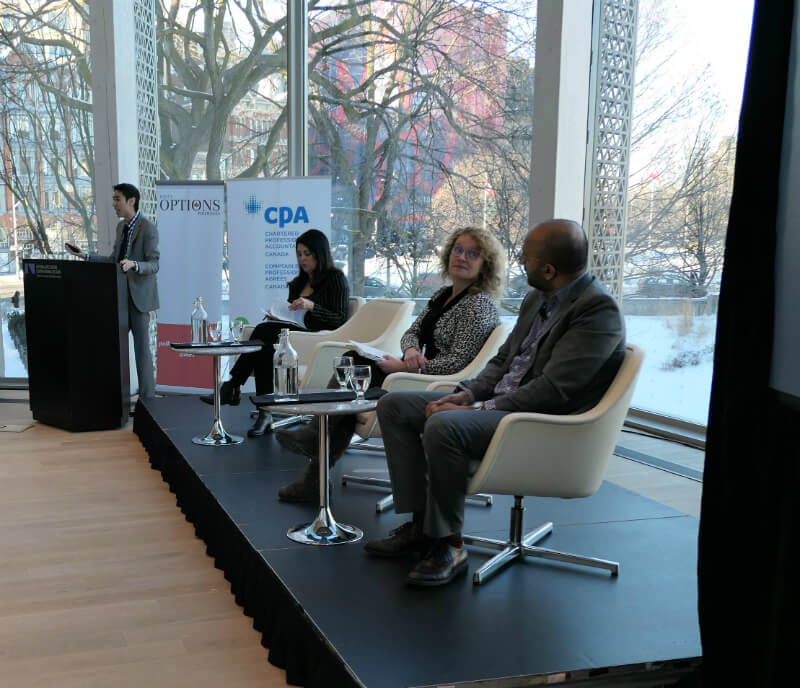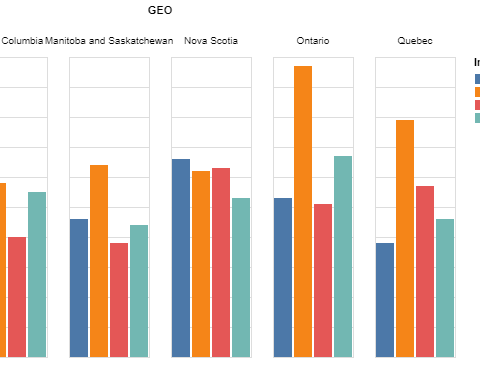Three labour experts have highlighted the critical need for radical changes in government policies and programs that are out of step with the current realities of most Canadians’ work lives.
They were speaking at a panel discussion on “In Search of the Next Gig: A Snapshot of Precarious Work in Canada Today” in Ottawa on January 25, hosted by Policy Options Magazine, a digital publication of the Institute for Research on Public Policy (IRPP). Moderating the panel was Jennifer Ditchburn, editor of Policy Options, and former journalist with the Canadian Press (CP).
“If we are to walk the walk that matches our talk about how inclusive we are in Canada, those who create our labour policies and programs should take a close look at the precarious work situation that most Canadians are caught in, and design their policies accordingly,” commented Sunil Johal, one of the three panelists. Johal is policy director at the Mowat Centre, an independent public policy think-tank, associated with the University of Toronto’s School of Public Policy and Governance.
The other two panelists were Francis Fong, Chief Economist with the Chartered Professional Accountants of Canada (CPAC) and Wendy Vuyk, regional coordinator of the Eastern Ontario Region at the Ontario Centre for Workforce Innovation.
“Most policies and programs intended to support Canadian job seekers are tied to conventional ideas of employment and were designed for the 1950s when there was a 9 to 5, lifelong job for the wage earner in a typical family,” he said.
Fong, Johal and Vuyk analyzed the changes that have sent the labour market into a tailspin, leaving employees with few options other than what all three, as well as Ditchburn termed “precarious work,” – short term jobs with no stability, few or no benefits, and no prospects of leading to a lifelong career path.
“We need a formal definition of precarious work because precarious work will define our future.” -Francis Fong
A major cause of the erosion of stable jobs and the growth of precarious employment was the decline of the manufacturing sector in the 1990s and early 2000s and the growth of the high-tech sector, the panelists explained.
Research challenges
Fong pointed out that even research on this topic is lagging behind the times. He emphasised that in order to capture the nuances of this new workforce reality, researchers need a clear definition of the term “non-standard work”, an umbrella term for all kinds of precarious work.
He said that the lack of consensus on a definition of precarious work poses a serious challenge for researchers, whose work underpins policy decisions.
“We need a formal definition of precarious work because precarious work will define our future,” he said.
He added that no single government agency is collecting all the relevant data, although Statistics Canada has been tracking it since the 1990s, a period which saw the rapid rise of this phenomenon.
The problem is further complicated, he said, by the need for the involvement of so many sectors –labour, immigration, the provincial and federal governments, as well as the private sector.
Stagnant wages, declining unionization
Highlighting another major problem, Johal discussed the disconnect between Canada’s overall economic growth and workers’ wages.
“While the economy continues to grow, wages have become stagnant,” he said, adding the costs of food, housing, childcare and other necessities have also gone up.
Johal also referred to the decline of unionization, which added to worker’s problems.
“Workers have nobody to represent them and speak about their issues,” he said.
He said the most vulnerable were the 30 percent of workers who were in precarious jobs because they had no other option, as opposed to the 70 per cent who did this type of work by choice.
“We need to focus on that 30 percent and to refresh our social policies and programs to address their needs,” he said.
Preparing for the future world of work: An optimistic outlook
Vuyk’s presentation focused on preparing for the future, given the changing economic landscape which she termed the “fourth industrial revolution.”
“Sixty-five percent of today’s elementary school children will work in jobs that don’t exist today,” she predicted.
Nevertheless, she presented an optimistic outlook, saying that although jobs will be lost, others will be created by new inventions.
She emphasized the need to train young people to become entrepreneurs and to think about their careers as a business.
She called on educators to emphasize soft skills such as communication, financial literacy, cross-cultural sensitivity, flexibility and adaptability.
She said it was important for also parents and guidance counsellors to understand that university is not the only key to gainful employment.
She advised parents to give their children as many life-broadening experiences as possible, including travel.
“We have to create a culture of lifelong learning,” she concluded.
This piece is part of the “Ethnic Women as Active Participants in Ontario” series.
Ottawa-based writer/journalist, editor, blogger, communications professional seeking freelance opportunities in political and travel writing.





